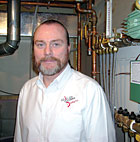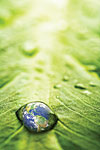
Gerry Wagner
In my work with thermal solar systems (TSS), I have become increasingly concerned about products and systems that are being bunched together under the moniker of being green but when one looks a bit closer, the shade of green may be in question.
MY POINT
I am fortunate to have many friends in the HVAC industry and many of them are getting involved in one way or another with solar products. A company who is very close to my heart, which is announcing a TSS product offering this year, sent me some information on their intended offering and asked my opinion. The product is a fine TSS manufactured in Israel where TSS has a huge market for reasons which may or may not be obvious - no one would sell the Israelis oil so necessity literally became the mother of invention and TSS are found on virtually every home and building in the region.My concern with a TSS product from Israel coming to market here in the United States is strictly a logistical one - how green can a product be when it has to travel 6,900 miles via container ship to get here? Ships measure their fuel usage in pounds of fuel per horsepower, per hour. Good fuel economy on a container ship is 0.25 lbs/hp/hr.
A typical container ship has engines totaling 100,000 hp. That all said, this works out to 25,000 pounds of marine diesel fuel per hour. Marine diesel weighs about 7 pounds/gallon, which translates to about 3,600 gallons burned per hour. I understand that a typical container ship cruises at about 25 knots (about 30 mph), so to travel 30 miles the ship will burn 3,600 gallons and to go 6,900 miles, it will burn 828,000 gallons of fuel.
As a result, I don’t think I can call a TSS product from Israel green. According to Wikipedia, there are at least 49 shades of green so maybe the product should be called gray asparagus (no kidding) as both the color and the product’s initial carbon footprint doesn’t seem very green at all.

My concern for TSS products that travel thousands of miles to get here is reminiscent of the bamboo floor tile product which was all the craze here about 5-6 years ago. The general consensus at the time was “what could be greener than a floor tile made of an organic material such as bamboo?” Well, someone, (not me), started to calculate the devastation caused by less than environmentally friendly harvesting techniques and the fuel used to get the tile from Asia to the United States market and suddenly the shade of green changed for bamboo floor tile.
I am making a personal commitment to start seeing green in the totality of a product, not just in its perceived use and appearance. Good news is that there are U.S. manufacturers of TSS collectors and companies like Taco are getting involved in the control end of the TSS market. On the horizon, I know of a guy who is planning on launching a TSS product sometime this year, (waiting on his OG300 certification), which will utilize components that are all made here in the U.S. and has the potential to bring TSS to the masses based on system simplicity and low initial cost. This is a system which has the potential to be really green.
Bottom line, maybe we need to start seeing green as red, white, and blue.
Publication date:06/28/2010

Report Abusive Comment